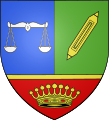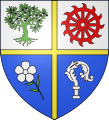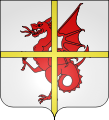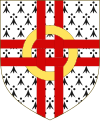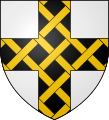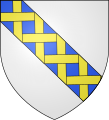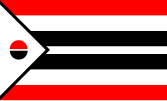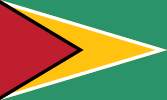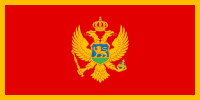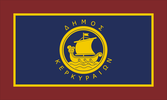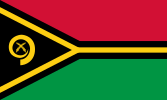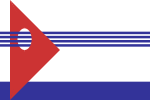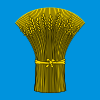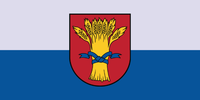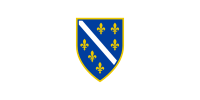|
Fillet (heraldry) In English-language heraldry, the fillet is considered a diminutive of the chief. It is defined as occupying one fourth the width of the chief and typically positioned at its bottom edge.[1] When so positioned the chief is blazoned as supported by the fillet; but, when the chief is charged by the fillet, as when the fillet positioned at its top edge[2] or middle, the chief is blazoned as surmounted.[3] Another term for the former, supported, is sustained.[4] In French heraldry, terms for this charge are divise[5] and filet en chef.[6] The term chef retrait has also been used.[7] The fillet or divise placed beneath the chief is of a different tincture than the field,[8] evidently to avoid violations of the rule of tincture (see Berry 1828[9]). There are other uses of the English fillet that are similar to its use above as diminutive of the chief. The term is used by some for a diminutive of the fess narrower than the bar, as a synonym for barrulet.[10] It is also used by some more generally for a narrow band as charge that can be positioned variously on the field—as a diminutive of the bend, as synonym of riband[11] as well as the fess, as synonym of barrulet. This latter use parallels that of the cognate term filet in French heraldry, where it is possible to speak of the filet "en fasce, en pal, en bande, en barre, en croix, en sautoir, en chevron, en parle" (fillet in fess, in pale, in bend, in bend sinister, in cross, in saltire, in chevron, in pall).[12] (See #Fillet as adjective below.) Such uses of the term fillet in English (or filet in French) often employ it as term for a component element of other devices such as the cross parted and fretted,[13] the ordinary the fret, or the variation of the field fretty.[14] 'Fretted' and 'fretty' refer to the interlacing of the fillets.[15] The Jumelle (Eng. bar gemel, etc.) and Tierce are other charges also said to be composed of filets.[16] The cottise, or cost, has been described as having the "appearance of a fillet placed beside the principal ordinary"[17] and at least one author terms it a fillet.[18] The pentagram has even been described as a "star reduced to an interlaced fillet".[19] This use of the term, as the diminutive of an ordinary or component of a complex charge, is to be distinguished from other uses of the term fillet in heraldry. See section #Other uses of fillet in a heraldic context below. Fillet as adjectiveIn English-language heraldry, diminutives of the cross, saltire, and pall reduced to one-fourth the thickness of the ordinary are known as the fillet cross, fillet saltire, and fillet pall.[20] The adjective 'fillet' is used to denote a mode of diminution achieved by a reduction in thickness, to typically one-fourth that of the ordinary,[21] without any corresponding reduction in the extent of the charge, in terms of length or width, or both. The fillet cross and fillet saltire occupy the full length and breadth field, as the cross and saltire as ordinaries do. In French heraldry, there is also the filet en pairle, or 'fillet pall'.[22] Other diminutives of ordinaries reduced the thickness of a fillet (1/4 or less of the ordinary) have more specific names proper to themselves in both English and French heraldry. In French heraldry, the 'fillet bordure', adhering to the outer edges of the field in the same manner as the bordure, is the filière.[23] In English heraldry, the 'fillet chevron' is the couple-close.[24] Filleting and fimbriationThe terms fillet and fimbriation share etymological roots with words associated with clothing, sewing and stitching. The word fillet derives from the Middle English and Old French filet, a diminutive of thread.[25] But the heraldic use may derive more proximately from use of the term for an item of clothing, a headband of white silk or linen worn to indicate sovereignty.[26] In its practical inspiration dating to the Age of Chivalry, as a cloth worn around the helmets of knights, sometimes by sons of nobles as a mark of cadency, the fillet is related to another heraldic charge, the lambel or label.[27] But the meaning of the word fillet extends to bands of metal historically worn around the head as marks of distinction, as crowns.[28] For its part, fimbriate derives from the Latin for 'fibers, fringe, and thread' and more proximately from the word for the skirt or hem of a garment, "implying an ordinary or charge bordered all round".[29] The use of the term 'fimbriation' for the bordering of ordinaries like crosses and bends that extends only to the edge of the field and does not fully encompass the charge, though common, is considered by authorities like William Berry to be likely mistaken.[30] Other uses of fillet in a heraldic contextAside from the use of the term fillet for the diminutive of an ordinary as a narrow band, the term is also used in a figurative-representational manner drawing on the meanings of fillet discussed above, as ribbon, cloth headband, or band of metal. In the first case, it is used to describe a decorative element of an achievement of arms, the figurative representation of a ribbon entwined around a helmet. The fillet in this sense is also frequently incorporated (twisted into) the torse.[31] In the second, the term is used for representations of cloth wrapped around the heads of 'Moors' or 'Saracens'.[32] When used thusly, the human figures portrayed with a candida fascia, after the diadem of the Roman kings, are blazoned diadameté.[33] A third use, resembling the two preceding, is for the representation of a band of cloth or bandage used to bundle a sheaf of wheat or arrows together.[34] Finally, the term is used for representations of a metal band, of gold, as a plain crown or as a component of a more elaborate crown.[35] A derivative of this usage, is the use of fillet to describe a design component of some heraldic representations of the fleur-de-lis,[36] such as that seen on the Flag of Quebec or the Flag of the Republic of Bosnia and Herzegovina (see section #Band as design element of fleur-de-lis below). GalleryCoats of arms
See also the Coat of arms of the Harvard Medical School, blazoned as "sustained by a fillet compony". Fillet in baseFillet cross and fillet saltire
As component of crosses parted and fretted
As component of fretty variation of the fieldOn flagsThe use of the fillet as diminutive of the chief is, on flags, quite rare.[37][38] However, the fillet as narrow band is used in a similar manner to offset other ordinaries like the base or sides (for examples, see the section #Fillet-adjacent diminutives* below). There are examples of the fillet as narrow band used on its own as a diminutive of charges such as the fess or bend (see same). There are examples of the fillet cross, fillet saltire, and fillet bordure (filière). And there are examples of the fillet used as component of other charges such as the Fret, the Jumelle, and the Tierce. Fillet-adjacent diminutives*Fillet pale, or endorse
Fillet fess, or barrulet
Fillet bend, or ribbon, riband
Fillet chevron, or couple-close
Fillet bordure, or filière
Fillet orle or tressure
See also Flag of Athens, Greece Fillet cross and saltire
Fillet pall
*In English language vexillology, many of these would likely be blazoned as instances of fimbriation or cottissing.[39] For 'fillet esquarre' as border of canton on two sides, see Esquarre (heraldry). As cost or single cottice
As component of Fret
As component of cross parted and fretted
As component of cross otherwise interlaced
As component of Jumelle and similar
As component of Tierce and other charges parted
Other uses of term filletAs headband or diademAs ribbon tying sheaf
Band as design element of fleur-de-lisSee alsoWikimedia Commons has media related to Fillet crosses in heraldry. Chief (heraldry)
References
|
Portal di Ensiklopedia Dunia



